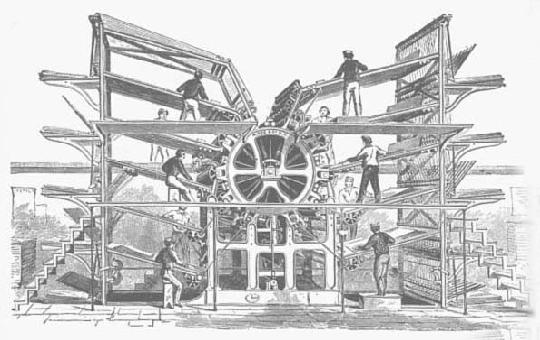|
* * * * * * * * * * * * * * * * * * * * * * * * * * * * * * * * * * * *
In 1845 and 1846, the firm of R. Hoe & Co. were busily engaged upon plans and inventions for presses which should meet the increased requirements of the newspapers in America. The result was the construction of a printing press known as the "Lightning" or "Hoe Type Revolving Machine," embodying patents taken out by Richard March Hoe, son of the founder, Robert Hoe. The basis of these inventions consisted in an apparatus for securely fastening formes of hand-set type-matter onto a large horizontal central cylinder, about 5 foot in diameter. This was accomplished by the construction of curved cast-iron beds, called 'turtles', one for each page of the newspaper. These were built to suit the specific layout of each paper - length, width and number of columns, depth of heading, rules, dashes and margins. Instead of quoins, adjustable bolts were used. The vertical column rules were tapered toward the feet of the type which caused the type to be held firmly †overall, and had tongues along the bottom which fitted into slots along the base of the turtle, which was afterwards bolted securely to the cylinder. It was found that, with proper arrangement for locking up, it could be held firmly in position, the surface formed an 'almost' true circle, and the cylinder revolved at speed without danger of the type falling out. Around this large central cylinder from four to ten impression cylinders could be grouped. The sheets were fed in by capable boys from both sides of the machine, and taken from the feed-board by automatic grippers, operated by cams inside the small diameter impression cylinders and which conveyed them around against the revolving forme of the central cylinder. Two composition forme rollers with riders attached were placed between each of the impression cylinders, a common ink fountain being placed at the bottom of the main type cylinder. The forme, or turtles occupied only one sixth of the large cylinder surface, the balance utilized as an ink distributing table, its surface being lower than that of the type, the inking rollers rising and falling alternately to place the ink. Sheet fliers, patented earlier by Hoe on other machines, consisting of a row of wooden fingers, delivered the printed sheets face up behind each feeding station. This machine printed one side of the sheet only, necessitating a further pass for the back-up.
From 1847, about 175 Type-revolvers of various dimensions were built, the last, a four cylinder, in 1876 - made obsolescent by curved stereo plates and web perfectors.
**There appears to be a great deal of variation between printers on this point!
† Type at the start and finish of a column line would actually be leaning slightly inwards or 'off their feet'. This was evidently not obvious on such a large diameter cylindrical surface.
Sources: Comparato, Frank. Chronicles of Genius and Folly, Culver City: Labyrinthos, 1979
._______Hoe, Robert. A Short History of the Printing Press, New York, 1902
* * * * * * * * * * * * * * * * * * * * * * * * * * * * * * * * * * * *
|
|



